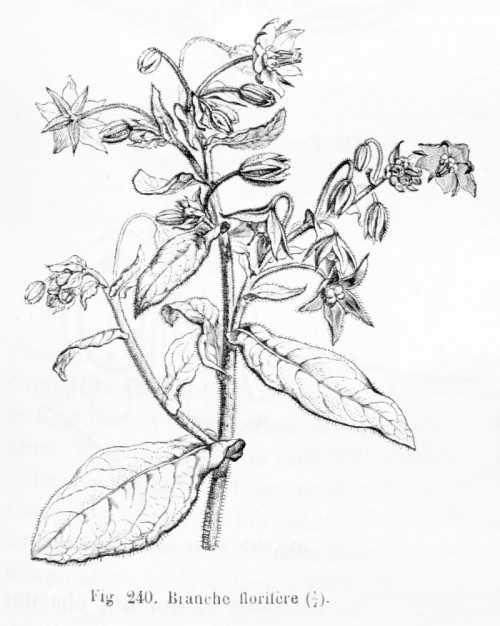Dies ist eine alte Version des Dokuments!
Borago officinalis L. - Boraginaceae - borage, starflower, tailwort, Boretsch, Borretsch, Gurkenkraut
Annual herb, up to 70cm tall, native to Europe, Mediterranean, naturalized and cultivated elsewhere; stems erect, branched; leaves alternate, 3-10cm long, elliptic to ovate; flowers petioled, wheel-shaped, bright blue, occasionally white, antheres black-violet.
„Traditionally borage was cultivated for culinary and medicinal uses, although today commercial cultivation is mainly as an oilseed. The seed oil is desired as source of gamma-linolenic acid (GLA), for which borage is the highest known plant-based source (17-28%)… Borage is used as either a fresh vegetable or a dried herb. As a fresh vegetable, borage, with a cucumber-like taste, is often used in salads or as a garnish… The flower…has a sweet honey-like taste and is one of the few truly blue-colored edible substances… Although often used in soups, one of the better known German borage recipes is the Green Sauce (Grüne Soße) made in Frankfurt.“
https://en.wikipedia.org/wiki/Borage
„Borago officinalis rosette leaves were sampled in the region of Amdoun (Tunisia) during different stages of their development. Essential oil contents varied from 0.01% to 0.13% respectively in young and adult leaves. Twenty three volatile compounds were identified. Hydrocarbons, mainly represented by nonadecane (29.8%), tetracosane (11.3%) and heptacosane (4.7%), constituted the major class in the young leaves (45.8%), followed by aldehydes (22.4%). The percentages of these two classes decreased to reach respectively 15% and 8.1% in adult leaves in favour of alcohols (57.9%) where cis-3-hexenol (29.6%) and hexanol (14.5%) were the main compounds.“
[Biochemical evaluation of borage (Borago officinalis) rosette leaves through their essential oil and fatty acid composition., Mhamdi, B., Aidi, W.W., Marzouk, B., The Italian journal of biochemistry, 56(2), 2007, 176-179]
„The essential oils obtained from the fresh leaves and flowers of Borago officinalis collected in the region of Amdoun (northwestern Tunisia) were examined by GC and GC/MS. Twenty-three volatile compounds were identified. The oil yields expressed on a dry weight basis were 0.14% and 0.24% for the leaves and flowers, respectively. The main compound determined in flower and leaf oil was (E,E)-2,4-decadienal with 43.4% and 26.9% in the leaf and flower oils, respectively. The oils from the two organs showed the predominance of the aldehyde class which constituted 61.2% and 61.9% in the leaf and flower oils, respectively. Other classes present in important percentages in the two organs were alcohols (22.4%) in the leaf oil and phenols (13.2%) and monoterpene hydrocarbons (12.2%) in the flower oil.“
[Volatiles from leaves and flowers of Borage (Borago officinalis L.)., Mhamdi, B., Wannes, W.A., Dhiffi, W., Marzouk, B., Journal of Essential Oil Research, 21(6), 2009, 504-506]
„Gas chromatography–mass spectrometry analysis of seed Borago officinalis essential oil (EO) revealed the presence of 16 volatile components. β-Caryophyllene (26%) and p-cymene-8-ol (19.7%) represented the major components, while nonadecane (0.7%) and hexanol (0.7%) were the minor ones. The EO composition was characterized by higher abundance of oxygenated monoterpenes (27.7%), followed by sesquiterpenes (26%). Fatty acid composition showed the predominance of linoleic (35.4%), oleic (24.2%) and γ-linolenic (20.4%) acids.“
[Biochemical characterization of borage (Borago officinalis L.) seeds., Mhamdi, B., Wannes, W.A., Bourgou, S., Marzouk, B., Journal of food biochemistry, 33(3), 2009, 331-341]
In the essential oil of young stalk leaves of B.officinalis (60 days after cotyledon appearing), by far the major compound was (E,E)-2,4-decadienal (66.8%). Besides this aldehyde, older leaves contained octanal, decanal and undecanal and the percentage of green alcohols, mainly (Z)-3-Hexenol and hexanol, rised. Monoterpene hydrocarbons like β-pinene and β-thujene were also present like traces of linalool, geraniol, β-damascone, β-ionone, eugenol, methyl eugenol, phenol and carvacrol.
[Fatty acids and essential oil composition of borage (Borago officinalis L.) stalk leaves during their development., Baya, M., Wissem, A.W., Marzouk, B., Rivista Italiana delle sostanze grasseI, 87(3), 2010, 196-200]

Baillon,H.E., Histoire des plantes, vol.10 p.343, fig.240,244 (1888-1891) [A.Faguet]
http://plantgenera.org/species.php?id_species=150653
